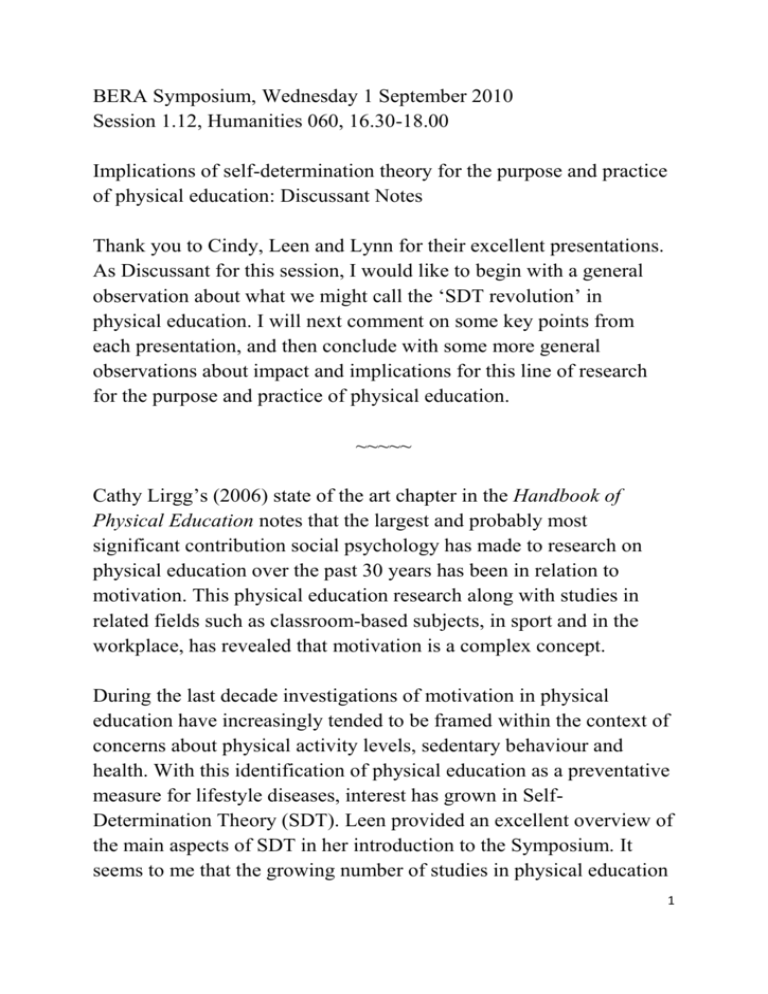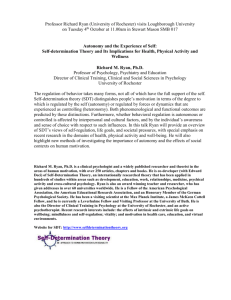Discussant Notes
advertisement

BERA Symposium, Wednesday 1 September 2010 Session 1.12, Humanities 060, 16.30-18.00 Implications of self-determination theory for the purpose and practice of physical education: Discussant Notes Thank you to Cindy, Leen and Lynn for their excellent presentations. As Discussant for this session, I would like to begin with a general observation about what we might call the ‘SDT revolution’ in physical education. I will next comment on some key points from each presentation, and then conclude with some more general observations about impact and implications for this line of research for the purpose and practice of physical education. ~~~~~ Cathy Lirgg’s (2006) state of the art chapter in the Handbook of Physical Education notes that the largest and probably most significant contribution social psychology has made to research on physical education over the past 30 years has been in relation to motivation. This physical education research along with studies in related fields such as classroom-based subjects, in sport and in the workplace, has revealed that motivation is a complex concept. During the last decade investigations of motivation in physical education have increasingly tended to be framed within the context of concerns about physical activity levels, sedentary behaviour and health. With this identification of physical education as a preventative measure for lifestyle diseases, interest has grown in SelfDetermination Theory (SDT). Leen provided an excellent overview of the main aspects of SDT in her introduction to the Symposium. It seems to me that the growing number of studies in physical education 1 informed by SDT demonstrates its strong appeal to researchers and its potential to assist us to reconceptualise our purposes and practices. Perhaps we might already reasonably begin to talk about the SDT revolution in physical education. I want to mention a few key points about each presentation in order to judge whether such a description might be justified. ~~~~~ The study by Rutten and Seghers provides an important advance in our knowledge of the relationship between motivation for school physical education and levels of habitual physical activity, including leisure-time physical activity. This in itself is a crucially important relationship for physical educators. We should recall that it has been a longstanding and ubiquitous aspiration for school physical education– indeed for some it is its raison d’etre – to promote young people’s lifelong participation in a physically active lifestyle. Methodologically, Rutten and Seghers supplement the use of one popular self-report measure, the activity diary, with pedometers, to measure the actual habitual physical activity participation of a large group of almost two and a half thousand 11-12 year olds. While their results are not unequivocal, they nonetheless point to a statistically significant relationship between motivation for school physical education and habitual levels of physical activity. This result, intuitively, makes sense. We could reasonably expect young people who are autonomously motivated to participate in school physical education to be more physically active habitually than their controlled and amotivated peers. At the same time, we cannot say whether there is a cause-effect relationship here of any kind, and need to develop 2 research designs that allow us to track the actual effects of particular interventions. As this line of research develops, we will want to ask about the detail of this relationship. For example, what was the nature of the physical education programme that these young people had experienced? And what is the nature of the physical activity that they participate in habitually, including in their leisure time? Given the range of physical activities that might legitimately contribute to school physical education curricula, and the varieties of ways of teaching these programmes, we will want to know whether different types of programme produce correspondingly different configurations of motivation. We will also want to know more about these factors and the nature of other physical activity experiences, including leisuretime activities, whether there is direct transfer of learning of activities learned in school to activities selected outside of school, or whether there is less direct transfer, so that leisure-time activity is high but relatively unrelated to what is learned in school. And behind these questions, we will also be correct to prompt SDT researchers to investigate the importance of age and phase of maturation. Age 11 to 12, as a case in point, is particularly problematic from the point of view of physical education, given the quite large individual differences that occur between chronological and maturational age in terms of physical size and neuro-muscular coordination. We might add to this issue another, about the availability of leisure-time physical activity in particular neighbourhoods and localities, and the extent to which sociodemographic factors impact on the relationship between motivation for school physical education and leisure-time physical activity. 3 But these are matters that will begin to shape the developing research agenda as SDT is used with ever increasing frequency in physical education. At the end of their presentation, Rutten and Seghers raise one further issue, which is the extent to which teachers may be able to raise levels of autonomous motivation in their physical education classes, thereby hopefully raising levels of habitual physical activity. It is this question that the presentations by Haerens and van den Berghe begin to address. The purpose of the study by Haerens and her colleagues was to consider the relationship between teachers’ motivational strategies and students’ motivation. Again, methodologically, this study seeks to advance previous research by developing an instrument that allows the direct observation of teachers’ actions in real physical education classes. In the language of SDT, the first purpose of this study was to observe teachers’ need supportive and thwarting behaviours. A particular set of teacher behaviours was identified that relate to the creation of a needs supportive environment such as attending to what students say and addressing them by their first names, in which we would reasonably expect to find higher frequency of autonomous motivation in students. However, Haerens and her colleagues recognise that there is no linear relationship between teacher behaviour and student motivation, since they also sought to account for students’ perceptions of teacher behaviour and whether they interpreted teacher behaviour as needs supportive or needs thwarting. While this factor adds complexity to the study it also adds to its ecological validity. In the event, Haerens and colleagues reported that much of the variance in student motivation can be explained not in terms of teacher behaviours or other features of the classroom environment but in terms of individual difference between pupils. In other words, 4 students within the same classes are likely to be motivated for physical education in different ways (autonomous, controlled, amotivated) which are not directly influenced by the real observed teacher’s behaviour. This is a key finding; how might we better plan for this situation, in terms of types of physical education programmes and teaching strategies? At the same time, Haerens’ data shows that what teachers do does matter to some extent, and that they can have an impact on student motivation to a limited extent within programmes as they are currently configured. Van den Berghe, Haerens and Vansteenkiste’s paper next explored the origins or antecedents of teachers’ need supportive behaviours and found that these relate both to personal and environmental (workplace) factors. A number of challenges emerge from their analysis. As their review of literature showed, when teachers’ perceive pressure from above or below to perform in particular ways, they are more likely to experience controlled motivation to teach and in turn behave in more controlled and needs thwarting ways with their pupils. This is a particularly important finding for teachers working in the inspection and target-driven culture that has overtaken education in the UK during the past 20 years. If as van den Berghe and her colleagues propose teacher need supportive behaviour has its origins both in personal characteristics such as gender and increasing age and experience, and in their local environment, how might teachers’ needs satisfaction be increased? Is it possible to counteract the negative effects of years of experience through, for example, better continuing professional development? What might teacher education courses do to better develop personal characteristics in young teachers that are closely aligned with needs supportive behaviours? How might workplaces be better organised to decrease stress and perceptions of pressure? 5 ~~~~~ To summarise the story line that emerges from these three papers, then, we have some evidence of a relationship between autonomous motivation for physical education and higher levels habitual physical activity. This relationship is of fundamental importance to physical education’s aspiration to promote lifelong physical activity. Teachers can play a limited but nevertheless important part in increasing levels of autonomous motivation for physical education among their students. Of considerable significance is the finding that much of students’ motivation for physical education is influenced not at the level of the school environment (including teacher behaviour) but at the level of individual characteristics. We need to think carefully and deeply about how we might take account of this factor in preparing teachers and planning programs of physical education. The origins of teachers’ needs supportive behaviours for teaching physical education themselves seem to be at both individual and environmental levels. Again this finding puts the onus on teacher education and continuing professional development to facilitate the development of particular personal characteristics in teachers that will enhance needs supportive behaviours in teaching physical education. Maybe, also investigating the underlying processes that affect teachers’ behaviours when they get older, does it relate to job satisfaction, is the difference due to differences in the way they were educated themselves, or due to characteristics of the workplace environment? Longitudinal studies, following the same teachers over time, are a possible means of addressing these questions. As Leen has already commented, the logic behind SDT for the practice of physical education is attractive and compelling. Nevertheless, the application of SDT poses a number of challenges for the practice and pedagogy of school physical education, not the least of which is the fundamental purposes of the subject in the school 6 curriculum. As Melinda Solmon (2006) points out, motivation has been regarded according to the cognitive mediation paradigm as one of a number of mediating factors between teaching and learning, along with perception, attention and affect. As Mark Byra (2006) notes, the traditional goal of physical education programs in the United States and elsewhere has been to develop the motor-skills of pupils in relation to a wide range of physical activities including games and sports. It is in this sense, that physical education has traditionally sought to develop the physical competences of young people, that motivation along with other ‘cognitive’ factors, can thought of as mediating between teaching and learning. As SDT has become prominent in the social psychological research literature on physical education, I suggest that motivation has shifted from being thought of as a mediating factor to become a learning outcome in itself. I suggest that this shift contains far-reaching implications for the practice of school physical education and its place and purpose in the school curriculum. The three studies presented today provide us both with methodological advances in the use of SDT and new and important insights. But we should note that if SDT is to be a revolution in physical education, there is still much to do before this line of research can make a difference to purposes and practices. I end this discussion with a short list of critical observations of the use of SDT in physical education with the intention, not of ending on a negative note, but of highlighting the challenges we face in realising the potential of this way of thinking about the purposes and practices of physical education: First, there is indeed within the SDT literature in physical education a shift in thinking about motivation from mediating factor to learning 7 outcome, with few studies including in their design the measurement of learning outcomes such as improved motor skills, ability to play games, etc.; As an allied matter, SDT studies invariably state as a rationale that physical education is a means of prevention of sedentary-related illnesses, and assume health-related exercise is the required form of physical activity (rather than PA with other foregrounded goals such as sport competition/ art/ personal development, etc); Third, few studies take account of the actual programs of physical education students in their samples have experienced, either in terms of the subject matter, or the teaching styles and other features of the learning milieu including facilities, equipment, school ethos, and so on; Fourth, interventive studies that have sought to manipulate some aspect of the learning milieu are often very short in duration, some as short as one lesson, in all likelihood too short to have an impact on the dispositions and values of students; Fifth, studies contain many prescriptions for teachers’ practice and teacher education, but tend to take the form of moral exhortations for individual teachers to heed the implications for practice suggested by SDT; Sixth and finally, few studies take account of the dominant program model in physical education and its associated pedagogy (direct instruction), its history, and how it has been shaped by the school as an institution (what Hal Lawson has called the ‘Industrial School’). 8 Notwithstanding these points, properly recontextualised within a pedagogical framework, SDT has important messages for the development of new forms of physical education within the digital age school serving the www 2.0 generation. But these new forms of physical education require radical reform of the subject befitting the descriptor of the ‘SDT revolution’. 9











